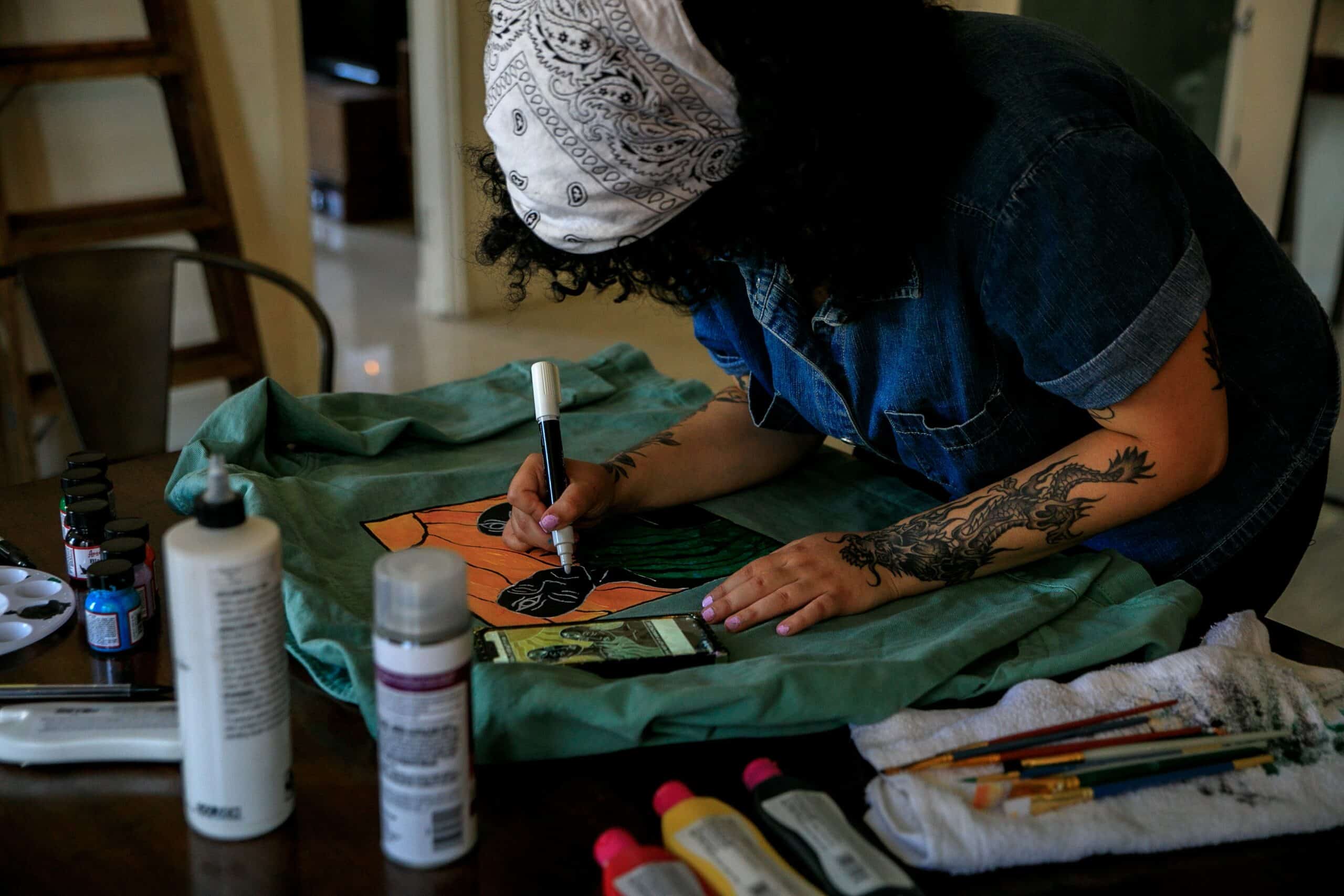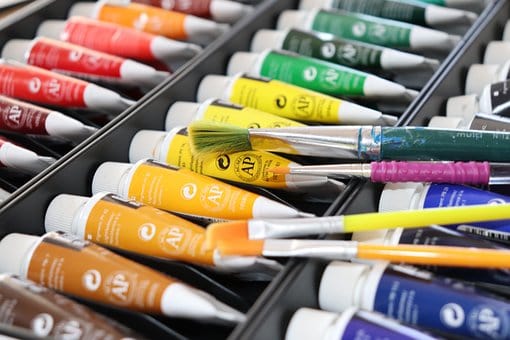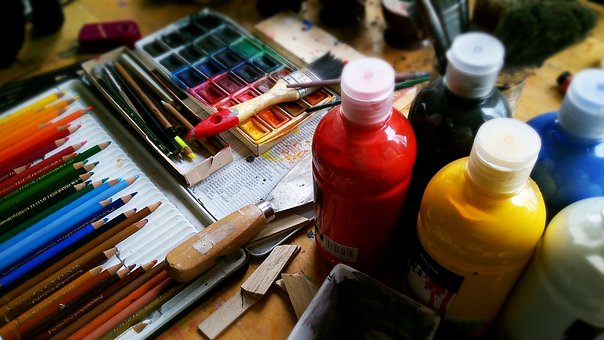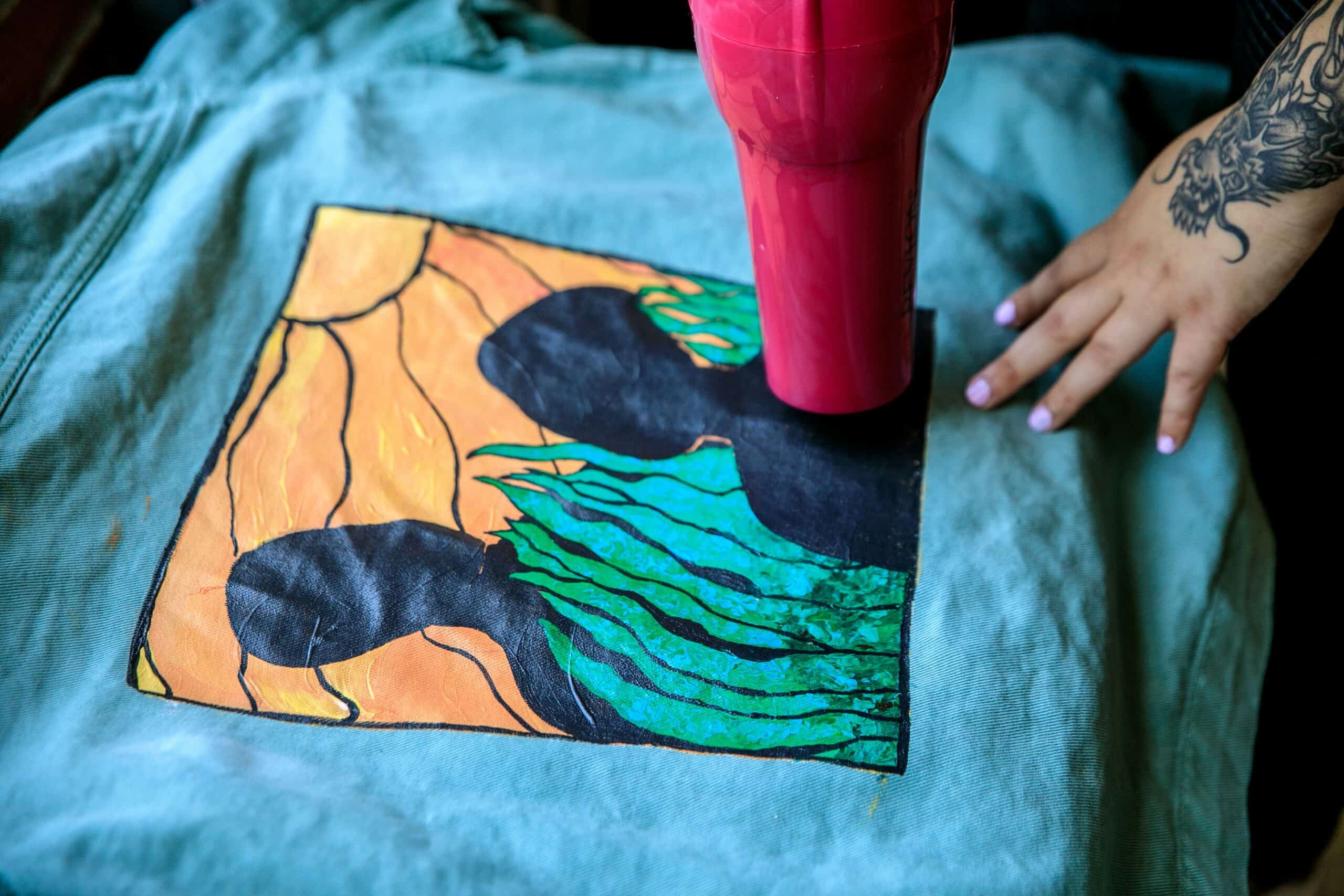How To Seal Acrylic Paint On Denim
Do you have an old pair of jeans that you want to spruce up with some art? Sealing acrylic paint on denim is easier than it sounds, and could just be the change your wardrobe needs! With a few household items, a bit of patience, and these easy-to-follow steps, you'll be ready to rock those newly decorated jeans in no time. So let's not beat around the bush - here's how to seal acrylic paint on denim like a pro!
Painting fabric can seem daunting at first, but once you know all the tricks of the trade it becomes second nature. It’s important to understand what materials are best for sealing acrylic paint onto denim before getting started. The most common method involves applying a coat of clear spray sealer after painting. This will help protect the artwork from fading or washing away over time. Additionally, using a heat setting process – usually done with an iron – will further ensure the longevity of your work.
By following these simple steps and choosing quality supplies, any novice painter can easily turn their favorite pair of blue jeans into one-of-a-kind works of art! So don't delay - read on to learn exactly how to seal acrylic paint on denim like a pro!
What Is The Best Way To Seal Acrylic Paint On Denim?
Have you ever wanted to add some flare to your denim wardrobe? With acrylic paint, it's easy to create unique designs and patterns on your jeans. But how do you make sure the design stays in place without fading or cracking? To ensure that your painted design lasts, you'll need to seal it with a protective coating. So what is the best way to seal acrylic paint on denim?
When sealing acrylic paint on denim fabric, heat setting is one of the most reliable methods for providing a durable finish. Heat setting involves using an iron or other type of heating element to bond the layers together. You should also apply an acrylic medium such as gel medium or varnish overtop of the painted surface before heat-setting. This will help lock in any loose pigments and provide additional protection against water and wear and tear.
For optimal results when working with different types of fabric, always use a low heat setting so as not to damage the material or cause discoloration from extreme temperatures.
Choose an appropriate cleansing method such as cold washing or dry cleaning rather than machine washing which could affect the durability of your paint job. Knowing what fabric works best for painting can also give you better results when sealing your artwork onto clothing; certain fabrics may be more prone to smudging and/or require multiple coats of sealant for maximum longevity.
Sealing acrylic paint securely onto denim requires taking into account several important factors: proper heat settings, suitable fabric type, and an adequate amount of acrylic mediums are all crucial elements for ensuring long-lasting effects. By following these simple tips, you can easily extend the life span of your creative designs!
What Type Of Fabric Is Best For Acrylic Painting?
Fabric painting is an art form that has been around for a long time, evoking memories of childhood days spent crafting colorful creations. With its versatility and vibrant hues, acrylic paint can be used to create beautiful designs on fabrics like denim. But when it comes to preserving your masterpiece, the question arises - what type of fabric is best for applying acrylic paint?
When selecting a fabric for use with acrylic paints, consider factors such as the quality of the fibers, whether or not they should be pre-treated with fabric dye, and how well the material will hold up after washing. Natural fibers such as cotton and linen are ideal for creating intricate works of art since their natural texture allows them to absorb paint easily without bleeding or smudging. However synthetic materials such as polyester may require special treatment before being painted to prevent fading during regular wash cycles.
The choice between using traditional acrylic paints versus specialized fabric paints depends largely on how much wear and tear you expect your masterpiece to endure over time. Fabric paints come in various forms including water-based ones which are more resistant to cracking than normal acrylics but aren’t quite as durable against abrasion damage due to their softer texture. On the other hand, if you're looking for something that's both waterproof and fade-proof then perhaps opting for permanent pigment dyes might be worth considering instead!

What Is The Difference Between Regular Acrylic Paint And Fabric Paint?
When it comes to fabric painting, a common question is what the difference is between regular acrylic paint and fabric paint. The answer lies in how they are formulated differently to adhere better to certain materials. Regular acrylic paints have a higher level of pigment which makes them great for canvas or wood surfaces but not as ideal for clothing. Fabric paint on the other hand has a lower level of pigmentation and contains special binders that help it stick better to fabrics such as denim.
The key to getting the best results when using regular acrylic paint on fabric is Liquitex Fabric Medium by Golden Artist Colors Inc. This medium forms an essential bridge between two dissimilar substrates; namely, cloth and acrylics, helping them adhere together so your artwork will stay put! It also works nicely with any color of regular craft or artist-grade acrylics, creating a flexible bond that won't crack over time as some other products may do.
In addition to using this product alongside your favorite colors of acrylics, there are several tips you can employ for making sure your project stays looking its best: First off, always use multiple thin coats instead of one thick coat - this helps keep the fabric from puckering due to too much wetting/drying cycles. Secondly, after each layer dries completely make sure you heat-set the medium into place with either an iron or hairdryer set on low heat. Finally, finish off your work with a light misting spray sealant once everything is finished drying - this helps protect the piece from stains and fading while allowing future touch-ups if needed.
These steps combined with Liquitex Fabric Medium guarantee that whatever you create will stand up over time and look just as vibrant now as it did when first painted onto denim material!

What Is The Best Fabric Medium For Acrylic Paint?
When it comes to crafting, you want your projects to be something special. That's why having the right fabric medium for acrylic paint is so important. You need one that will give you the best results and provide a long-lasting seal on any material like denim.
Imagining how vibrant colors could bring life to an old pair of jeans or a unique t-shirt design can make anyone excited about crafting! So let’s talk about what the best fabric medium for acrylic paint might be and where you can find it.
The craft store aisle is full of choices when it comes to picking out fabric mediums, but if you're looking for excellent quality with great coverage, Liquitex Professional Soft Body Acrylic is hard to beat! This product provides maximum flexibility while maintaining its vibrancy, making sure your project looks just as good after years as it did in the beginning. Plus, this particular brand offers different sizes so no matter what size project you have in mind, they'll have something perfect for you!
No matter which fabric medium you choose, remembering some key tips can help ensure success - mix it slowly into your paint until desired consistency is achieved; always test before applying onto larger surfaces; use more thin layers rather than fewer thick ones; and finally don't forget to set with heat once finished!
Now that we know what our options are regarding finding the best fabric mediums available – let’s take a look at what kind of results we should expect when using them.
What Are The Best Results When Using Fabric Medium?
When it comes to using fabric mediums for acrylic paint, there are many options available. However, when looking for the best results you want to make sure that you use a high-quality fabric medium. This will ensure that the textile paint has enough flexibility and durability so it can withstand normal wear and tear. Additionally, using a good quality fabric medium with your acrylic paint will result in vibrant colors and better coverage on fabrics like denim or other materials.
The type of fabric medium used is also important since some may not be compatible with certain types of paints or textures. For example, if the fabric is thick then a thicker formula might be needed to ensure even coverage throughout. If you're unsure which one would work best for your project, consult an expert before making any purchases.
No matter what kind of fabric you are painting on, it's always important to test out different techniques beforehand so that you know exactly what works best for each material. Taking time to experiment with different combinations of paints and mediums can help achieve desired results quickly and easily. With this knowledge in hand, you'll be able to create beautiful pieces effortlessly!
All these factors considered, it's clear that researching and testing various kinds of fabric mediums is essential for achieving the best outcomes when working with acrylic paints on textiles such as denim jackets. Knowing how to properly apply them can save time and money while still delivering stunning results. Now let’s look at what steps we need to take to understand how to paint a denim jacket most effectively.
What Is The Easiest Way To Paint A Denim Jacket?
Painting a denim jacket can be a fun and creative way to customize your look. But how do you get the best results? When it comes to painting on fabric, there are certain steps you need to take for the paint to stay put. The best acrylic paints for this project are ones that have been specifically designed for use on fabrics. To ensure long-lasting results, many people like to use a heat press or fabric sealer after the paint has dried. This helps the paint bond with the fibers of the material and makes it less likely to crack or flake off when worn or washed.
When using acrylics on denim, it's also important to mix them with fabric medium before applying them with a brush. This will help prevent cracking and fading over time. You may also want to consider adding an extra layer of protection with a fabric sealer once the paint is dry. This will form an additional barrier against wear and tear while making sure your design stays vibrant longer.
Picking the right materials and taking these extra precautions can make all the difference in getting excellent results when painting on denim jackets. So if you're ready to get creative, just remember that good prep work is essential!

How Long Will Acrylic Paint Stay On Fabric?
Painting a denim jacket is like writing on an empty canvas. You can express your creativity and make it look as unique as you want! One of the most popular materials used for these projects is regular acrylic paint, which offers vibrant colors that will last for years to come. But before embarking on this journey, many people wonder: how long does acrylic paint stay on fabric?
The answer depends largely on the type of fabric being painted; natural fibers such as cotton and denim tend to hold onto the color better than synthetic fabrics like polyester or nylon. For example, if you’re using regular acrylic paint on a denim jacket, you can expect it to last up to several years without fading or cracking. That said, there are steps you should take to ensure that the finish lasts longer - such as applying a protective sealant after painting.
So while it's true that regular acrylic paint may be one of the best options when giving new life to an old denim jacket, it's important to remember that proper care must be taken to keep its original beauty intact over time. From washing instructions to sealing techniques – knowing how exactly to keep your newly-painted design looking perfect is key.
Now let’s explore another common question: How can you make acrylic paint washable on fabric?
How Can You Make Acrylic Paint Washable On Fabric?
When it comes to making acrylic paint washable on fabric, there are a few options available. The best option for this is adding a Delta Fabric Medium to the mixture. This will help make the painted artwork more durable and also give it a softer feel. It's important to note that the amount of medium used should be equal parts paint and medium to ensure even coverage.
It's also worth considering using affiliate links when shopping online for fabric mediums as these can sometimes offer discounts on certain products. Additionally, if you're looking for something more affordable, you could try mixing your homemade medium with water or gel-based acrylic paints – though this may not always give the same results as store-bought fabric mediums.
Finally, taking into account all of these factors before beginning your project is essential for ensuring success when painting on fabrics such as denim. With careful consideration and preparation, you'll have no trouble creating beautiful works of art that last!

What Is The Best Option For A Craft Store Fabric Type?
When it comes to craft store fabric, there are many options available. It can be hard to know which one is best for acrylic paint projects. In this section, I'm going to break down the three main choices: oil paints, acrylic paint pens, and Angelus paint.
Oil paints provide great, long-lasting coverage but they take time to dry so you have to be patient when working with them. They also require solvents and thinners to clean up after use. So if you're looking for something quick and easy, these won't work for you.
Acrylic paint pens offer an alternative that's easier and faster than oil paints. These can give good coverage even on darker fabrics like denim without having to add any additional mediums or sealants. The downside of using acrylic paint pens is that the colors aren't always as vibrant as those from other types of paints, but their convenience makes them worth considering.
Angelus Paint is specifically designed for painting leather, vinyl, and other materials - including fabric! This type of paint offers strong coverage and vivid colors that stay true over time and resist fading due to sunlight exposure or washing cycles. However, since it's water-based rather than solvent-based like oil paints, it will need sealing once your project is complete to ensure its longevity – which may not be ideal if you're in a hurry!
No matter what type of fabric you choose for your project, make sure you do your research before getting started; different surfaces require different methods of preparation before painting with acrylics to get the most out of the results. That being said, each option has its own unique set of benefits depending on what kind of project you want to tackle!
What Type Of Acrylic Medium Should Be Used For Painting Fabric?
Searching for the best fabric paint to seal acrylic paint on denim can be a daunting task. Like finding the perfect needle in an ever-growing haystack. However, identifying which type of acrylic medium should be used is quite straightforward.
The best option when it comes to painting any kind of fabric is usually a fabric medium or specialized paint designed specifically for that purpose. Fabric medium helps enhance the color and coverage while also adding flexibility and durability so your masterpiece won't crack or peel off over time. It is important to remember that different types of fabrics require different kinds of paints, making it essential to find out what type of material you are dealing with before attempting a craft project using acrylics.
For denim, the ideal choice would be either an all-purpose fabric paint or an acrylic medium specially formulated for use on cotton fabrics such as jeans. These paints tend to have higher levels of pigmentation than other varieties and will help ensure better adhesion and vibrancy once applied. Additionally, they often contain additives that make them more resistant to fading over time, ensuring your design stays vibrant even after multiple washes. For these reasons, they're considered by many crafters as the best options when it comes to creating long-lasting works on denim fabric!
No matter what type of fabric you plan on painting, doing some research beforehand is key to getting optimal results - both aesthetically and functionally speaking!

What Is The Biggest Difference Between Natural And Synthetic Fabrics?
When it comes to fabrics, the differences between natural and synthetic fibers can be like night and day. From weight to durability to texture, there’s a lot that sets these two apart. Here are three of the biggest distinctions:
- Fabric Medium: Natural fabrics will often require a special fabric medium for acrylic paints to adhere properly. Synthetic fibers usually do not need any type of fabric medium added before painting with acrylics.
- Durability: Natural fabrics tend to have less resilience than their man-made counterparts; wear and tear can easily occur on delicate natural materials such as cotton or silk. On the other hand, synthetic fibers feature enhanced strength which makes them more resistant to damage over time.
- Texture: One of the most obvious differences is the feel of each material when touched. Natural fabrics such as linen typically have a soft, smooth texture while synthetics like polyester offer a crispier feeling against the skin.
So whether you're looking for an extra layer of protection for your denim or simply want something softer against your skin, consider how natural or synthetic materials might suit your needs best - then choose accordingly! With this knowledge in mind, let's move on to what is the best choice of fabric sealers and protective coatings.
What Is The Best Choice Of Fabric Sealers And Protective Coatings?
When it comes to fabric sealers and protective coatings, the choice can be overwhelming. Did you know that an estimated 28 percent of finished goods are coated with a type of fabric sealer? As such, it's important to select the right one for your project. For example, when sealing acrylic paint on denim, parchment paper, and heat guns are often used in combination with an acrylic sealer. Parchment paper is great at protecting the surface underneath from any accidental spills or drips while also allowing airflow during the curing process. An acrylic sealer will help prevent fading and cracking over time.
A heat gun serves as a finishing touch by setting the sealant quickly without burning the material being sealed - something which could happen if too much direct heat is applied to fabrics like denim.
Choosing the best fabric sealer depends on what kind of protection you need; some materials may require special treatments given their unique properties. With all this in mind, it’s essential to understand how to correctly use heat when applying acrylic paints to ensure a successful finish and long-lasting results.
What Is The Right Way To Use Heat To Set Acrylic Paint?
When it comes to sealing acrylic paint on denim, using heat is a great option. To do this correctly and get the best results, you'll need some good-quality supplies and tools. Here's what you should have:
- A heat gun – preferably one with high heat settings
- Acrylic fabric paints that are specifically designed for use on fabrics
- Denim or other fabric of your choice
- An ironing board or wood block.
The process begins by pre-washing the denim and allowing it to dry completely before starting any painting. Once this is done, you can start applying the fabric paint to whatever design you want. Let each layer of paint dry before adding another layer so that the colors don’t mix. After all layers of paint have dried well, take out the heat gun - ensuring that it's set at its highest setting - and slowly go over each painted area with the hot air from the gun. This will help seal the paint better onto the fabric and make sure it doesn't run off when washed later.
It's also important to keep safety in mind while doing this project as heat guns can cause burns if not handled properly. Make sure your workspace is well-ventilated during this process to avoid inhaling fumes from melting plastic or other materials within your surroundings. With these tips in mind, you're now ready to begin creating beautiful designs with sealed acrylic paints!

What Other Types Of Paints Can Be Used For Fabric Art?
Let's face it - who doesn't want to create vibrant works of art with fabric? Whether you're a professional artist or just starting, there are plenty of ways to make your fabric project look amazing. But when it comes to acrylic paint designs on denim, you might be wondering what other types of paints can be used instead. Well, irony alert: the answer is quite a few!
To begin with, consider using a fabric medium for the best results. This will help ensure that the paint does not crack once applied and will also make sure your design stays put after washing and drying. Additionally, water-based dyes provide an intense color range, great for those looking for something bolder than traditional acrylics. There are also various specialty paints such as glow-in-the-dark options and even sparkly glitter varieties that can add some extra oomph to any project.
Finally, if you want to take things up a notch, try using multiple layers of different paints in combination with one another. For example, mix regular acrylics with metallics or use textured paints alongside glossy ones – all depending on the desired effect you’re striving for! With this type of creative experimentation, there’s no telling what kind of unique masterpiece you’ll end up creating! Transitioning into our next section then; how can we create vibrant colors and works of art with acrylic fabrics?
How Can You Create Vibrant Colors And Works Of Art With Acrylic Fabric?
Creating vibrant colors and works of art with acrylic fabric is like painting a picture, but on textiles. It's an amazing way to express yourself through fashion or decor! With the right tools and techniques, you can make colorful masterpieces that are sure to turn heads.
Using acrylic paint for fabric art requires some additional supplies such as a fabric medium which helps the paint adhere better when cured. You also want to take extra precautions when prepping your fabrics by washing them prior so dirt doesn't get in the way of your masterpiece. When it comes time to start painting, use light coats rather than heavy ones; this will help prevent cracking and bubbling once dry. To finish off your project, be sure to heat set it according to manufacturer instructions using either an iron or a hot plate presser - this seals in all those bright colors for years down the road!
Acrylics have been used in everything from t-shirts and jeans to quilts and pillow covers. They provide endless options for color mixing and layering effects that result in truly unique pieces of artwork that won’t fade away over time. Whether you're looking to create something one-of-a-kind or just add a little bit of pizzazz to everyday items around the house, acrylic fabric art has got you covered!
Frequently Asked Questions
Seeking to protect a beloved denim item with acrylic paint can be an exciting endeavor. Craftspeople and artists alike are often looking for ways to transform their garments into works of art. Lastingness is paramount in this process, so one must consider the longevity of the project before commencing it. This begs the question: how long will the acrylic paint last on denim?
The answer varies depending on the quality of the fabric used, as well as any other factors such as weather or care instructions followed after painting. Generally speaking, if sealed correctly with a suitable sealant that is applied overtop of the original coat of paint, then results should remain vibrant and intact for several years. The key here is proper sealing – without it, even top-notch paints may succumb to wear and tear sooner than expected.
To ensure lasting protection from fading and destruction, it’s best practice to diligently adhere to all steps involved in properly applying acrylic paint onto denim fabric. Following these guidelines carefully will guarantee your design remains strong and beautiful for years to come!
Painting denim is like creating a vibrant canvas of art. Stitching together unique patterns and colors can be a fun way to express your style. But how many layers of acrylic paint should you apply?
Adding multiple coats of paint will create depth in the design and make sure the color stays bright for longer. Generally, two or three good-quality layers should offer enough coverage for most projects. Be sure to let each layer dry fully before applying the next one; that way, the coating will stay sealed and protected from fading over time.
When working with any type of fabric, use gentle brush strokes while painting so as not to disturb the weave too much. As a bonus, mixing a small amount of textile medium into each coat helps seal the overall finish even better! With these simple techniques in mind, you’ll have no problem mastering this crafty project in no time at all!
As the saying goes, ‘An ounce of prevention is worth a pound of cure.’ When it comes to sealing acrylic paint on denim, this couldn’t be truer. Sealing in your hard work will prevent any future chipping or fading and ensure that your design stands out for years to come!
Let’s take a look at what you can do to make sure your masterpiece stays put. First off, layering multiple coats of acrylic paint creates a waterproof base when applied correctly. This means applying thin layers to avoid clumps or cracks that could damage the finished product. Additionally, you’ll want to use a sealant over the top layer as extra protection against water or dirt damaging your artwork. The best way to go about this is using an aerosol spray-on sealant like Polyurethane or Mod Podge which provides flexible coverage without affecting its texture or color.
The key takeaway here is finding the right balance between taking precautionary steps and protecting your outcome. Although this may seem daunting at first glance, once you get familiar with the process it becomes second nature; guaranteeing both longevity and appreciation for your artistry! So why not start practicing now? It’s never too late – let yourself shine through vibrant colors and dazzling designs!
Painting denim is a tricky process, but with the right techniques and materials, you can achieve a smooth finish. To get started on your creative journey in denim artistry, it’s important to understand the key considerations for success: what type of paint should you use; how do you seal the paint; and how best to apply it?
When selecting paint for painting on denim, acrylic paints offer an excellent option due to their flexibility and durability. They provide vibrant colors that are also highly resistant to fading over time. Additionally, when sealed properly they will not crack or peel away from the material.
To ensure your work remains waterproof and durable, sealing acrylic paint onto denim is essential. There are various methods available to achieve this such as using heat-setting treatments or applying layers of varnish or polyurethane. The most effective way however is by adding several coats of fabric medium – which acts like glue between the fabric fibers and the paint – before ironing it into place with a hot iron.
Applying acrylic paint smoothly onto any surface requires patience and practice – especially when working with denim! But there are some helpful tips you can follow including preparing your canvas correctly by washing the jeans first; stretching out areas where wrinkles may form; dabbing rather than brushing strokes to avoid clumping; and layering thin coats instead of one thick coat – letting each layer dry completely before moving onto the next. With these steps in mind, achieving that perfect finished look will be within reach!
I’ve seen some amazing denim jackets with beautiful acrylic paint designs. I love how the colors pop out, and it makes me want to try out painting on denim myself! But then again, I wonder if the paint will stay intact for a long time.
The good news is that you can protect your work of art by sealing the acrylic paint on denim. Sealing helps keep the vibrant colors looking great for longer periods. But what’s the best way to do this?
One popular method is to apply a sealer or varnish over the design once it has dried completely. You may need to re-apply every few months depending on how often you wear and wash your jacket. This ensures that all those awesome colors don’t fade away too quickly. TIP: Consider using a fabric medium when mixing your acrylic paints – this will help make them more flexible so they won’t crack easily after being sealed.
Conclusion
In conclusion, painting denim with acrylic paint can be a great way to add color and detail to any outfit. With the right preparation and protection, your artwork can last for many years. If you take the time to apply several layers of paint and seal it properly, your design will be waterproof as well as durable.
The best way to achieve a smooth finish is by using multiple thin coats of paint instead of one thick layer. When applying each coat, use even strokes in one direction so that the colors blend seamlessly. Once all the coats are finished drying, make sure to seal the design with an acrylic sealer or varnish so that it lasts longer on your favorite pair of jeans.
By taking these steps, you can create beautiful art on denim while ensuring its longevity. Painting denim with acrylic paints can be incredibly rewarding; however, proper sealing techniques must be applied for your masterpiece to remain intact over time!






